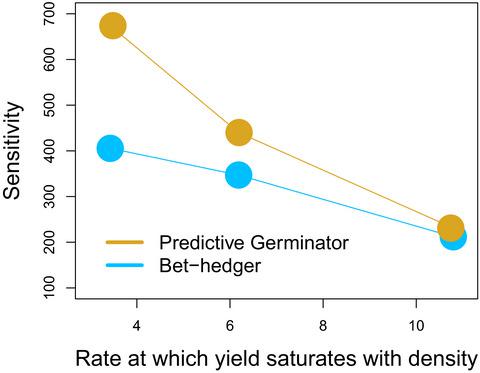Our official English website, www.x-mol.net, welcomes your
feedback! (Note: you will need to create a separate account there.)
The influence of life-history strategy on ecosystem sensitivity to resource fluctuations
Journal of Ecology ( IF 5.3 ) Pub Date : 2021-09-08 , DOI: 10.1111/1365-2745.13779 Andrew J. Felton 1 , Robin E. Snyder 2 , Robert K. Shriver 3 , Katharine N. Suding 4 , Peter B. Adler 1
中文翻译:

生命史策略对生态系统资源波动敏感性的影响
更新日期:2021-09-08
Journal of Ecology ( IF 5.3 ) Pub Date : 2021-09-08 , DOI: 10.1111/1365-2745.13779 Andrew J. Felton 1 , Robin E. Snyder 2 , Robert K. Shriver 3 , Katharine N. Suding 4 , Peter B. Adler 1
Affiliation

|
- To cope with uncertainty and variability in their environment, plants evolve distinct life-history strategies by allocating different fractions of energy to growth, survival and fecundity. These differences in life-history strategies could potentially influence ecosystem-level dynamics, such as the sensitivity of primary production to resource fluctuations. However, linkages between evolutionary and ecosystem dynamics are not well understood.
- We used an annual plant population model to ask, when might differences in plant life-history strategies produce differences in the sensitivity of primary production to resource fluctuations?
- Consistent with existing theory, we found that a highly variable and unpredictable environment led to the evolution of a conservative strategy characterized by relatively low and invariant germination fractions, while a variable but predictable environment favoured a riskier strategy featuring more variable germination fractions. Unexpectedly, we found that the influence of life-history strategy on the sensitivity of production to resource fluctuations depended on competitive interactions, specifically the rate at which production saturates with the number of competing individuals. Rapid saturation overwhelms the influence of life-history strategy, but when production saturates more slowly, the risky strategy translated to high sensitivity, whereas the conservative strategy translated to low sensitivity.
- Empirical estimates from Sonoran Desert annual plant populations indicate that production saturates relatively rapidly with the number of individuals for most species, suggesting that life-history differences are unlikely to alter sensitivity of production to resource fluctuations, at least in this community.
- Synthesis. Our modelling results imply that research to understand the sensitivity of primary production to resource fluctuations should focus more on the intraspecific competitive interactions shaping the density–yield relationship than on the life-history strategies that determine temporal risk-spreading.
中文翻译:

生命史策略对生态系统资源波动敏感性的影响
- 为了应对环境中的不确定性和可变性,植物通过将不同部分的能量分配给生长、存活和繁殖力来进化出不同的生命史策略。这些生活史策略的差异可能会影响生态系统层面的动态,例如初级生产对资源波动的敏感性。然而,进化和生态系统动力学之间的联系尚不清楚。
- 我们使用年度植物种群模型来询问,植物生活史策略的差异何时会导致初级生产对资源波动的敏感性差异?
- 与现有理论一致,我们发现高度可变和不可预测的环境导致了以相对较低和不变的发芽分数为特征的保守策略的演变,而可变但可预测的环境有利于具有更多可变发芽分数的风险更高的策略。出乎意料的是,我们发现生活史策略对生产对资源波动的敏感性的影响取决于竞争相互作用,特别是生产随着竞争个体数量而饱和的速率。快速饱和压倒生活史策略的影响,但当生产饱和度较慢时,风险策略转化为高敏感性,而保守策略转化为低敏感性。
- 索诺兰沙漠一年生植物种群的经验估计表明,大多数物种的产量随着个体数量的增加而相对迅速地饱和,这表明生活史的差异不太可能改变产量对资源波动的敏感性,至少在这个社区中是如此。
- 合成。我们的建模结果意味着,了解初级生产对资源波动敏感性的研究应该更多地关注塑造密度-产量关系的种内竞争相互作用,而不是决定时间风险传播的生活史策略。











































 京公网安备 11010802027423号
京公网安备 11010802027423号